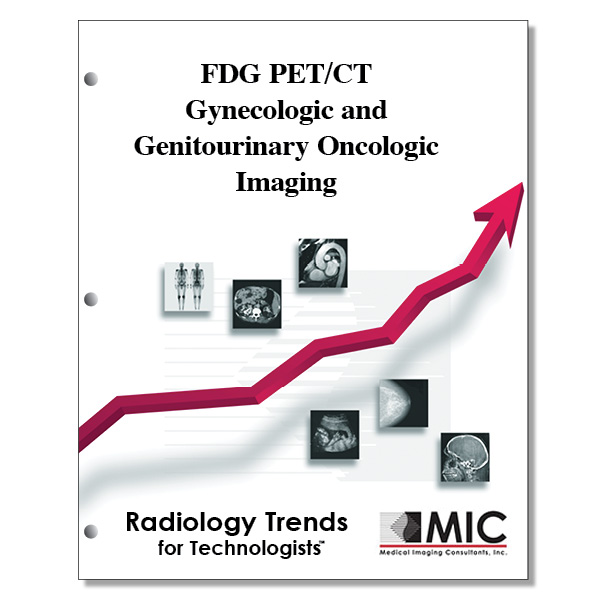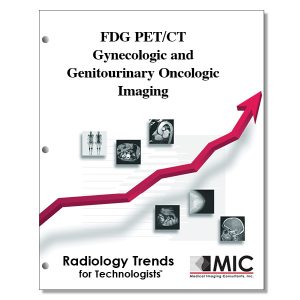

FDG PET/CT Gynecologic and Genitourinary Oncologic Imaging
A review of imaging protocols, patient preparation and common pitfalls in the use of FDG PET/CT for assessment of gynecologic and genitourinary tumors.
Course ID: Q00527 Category: Radiology Trends for Technologists Modalities: CT, Nuclear Medicine, PET, Radiation Therapy2.5 |
Satisfaction Guarantee |
$29.00
- Targeted CE
- Outline
- Objectives
Targeted CE per ARRT’s Discipline, Category, and Subcategory classification for enrollments starting after January 30, 2024:
Nuclear Medicine Technology: 2.50
Image Production: 0.50
Instrumentation: 0.50
Procedures: 2.00
Endocrine and Oncology Procedures: 2.00
Outline
- Introduction
- FDG PET/CT Imaging Protocol
- Technical Pitfalls
- Attenuation Correction
- Misregistration
- Limitations and Pitfalls of Gynecologic and Genitourinary Oncologic FDG PET/CT
- Physiologic Pitfalls
- Endometrial and Ovarian Uptake
- Bowel Activity
- Tracer Excretion
- Brown Adipose Tissue Uptake
- Low-Level FDG Uptake
- Prostate Caner
- Cystic and Mucinous Tumors
- Necrotic Lymph Nodes
- Peritoneal Carcinomatosis
- Ovarian, Tubal, and Uterine Disease
- Ovarian and Tubal Disease
- Uterine Disease
- Kidney and Urinary Tract Disease
- Kidney
- Urinary Tract
- Conclusion
Objectives
Upon completion of this course, students will:
- know the various abbreviations utilized in the article relating to GYN and GU oncologic imaging
- be familiar with the aspects of FDG PET/CT to review for patients with ovarian cancer
- know the basic components of PET/CT imaging techniques for GYN and GU oncologic imaging
- recognize the basic mechanism of FDG uptake and metabolism within the body
- be familiar with the indications for FDG PET/CT use for GYN malignancies
- be familiar with the indications for FDG PET/CT use for GU malignancies
- know the patient preparation steps and scanning protocols recommended by the SNM and EANM for FDG PET/CT imaging of GYN and GU malignancies
- understand why the timing of post-therapeutic FDG PET/CT for response assessment in GYN and GU malignancies is often crucial
- be familiar with structures and material that can lead to potential attenuation artifacts, making it essential to evaluate both attenuation-corrected and non-attenuated-corrected PET images
- understand PET/CT misregistration and know the ways to reduce and prevent it
- identify the areas or conditions whose assessment may be limited due to respiratory motion during the CT and PET components of a PET/CT study
- know the conditions that can possibly mimic or mask disease in GYN and GU oncologic FDG PET/CT due to the low specificity of FDG uptake
- be familiar with the variation of physiologic FDG uptake within the endometrium during a premenopausal woman’s menstrual cycle
- identify the possible causes of ovarian FDG uptake in premenopausal women and how the physiologic uptake manifests
- know the additional correlative information needed when visualizing endometrial or ovarian FDG activity in postmenopausal women
- be familiar with the regions of the GI tract where possible physiologic FDG activity can be particularly intense
- be familiar with the possible components for the mechanism of physiologic FDG activity in the bowel
- distinguish between the typical appearance of physiologic and that of pathologic FDG uptake in the bowel
- be familiar with some non-pathologic bowel conditions that can mimic the typical pathologic FDG bowel activity pattern
- be familiar with the typical glucose and FDG excretion pattern and the importance of using correlative information for corrected image interpretation
- know the regions of the body where brown adipose tissue can typically be found
- recognize what patient groups may demonstrate FDG uptake more than other groups
- understand why FDG PET/CT plays a limited role in the assessment of prostate cancer
- be familiar with the reasons why FDG PET/CT is thought to have low sensitivity for cystic and mucinous tumors
- be familiar with the important role of FDG PET/CT in the assessment of lymph node involvement in GYN and GU malignancy staging, and especially in the assessment of cervical cancers
- recognize the importance for the detection of peritoneal carcinomatosis in patients with ovarian cancer
- be familiar with the situations in which false negative results may occur with integrated FDG PET and contrast-enhanced CT for peritoneal disease
- know the imaging modality of choice for adnexal masses
- be familiar with benign conditions and masses that may yield false-positive results with adnexal and/or tubal FDG uptake
- be familiar with the characteristics of benign uterine leiomyomas that are thought to regulate their wide range of variable FDG uptake
- understand the role of FDG PET/CT imaging for renal cell carcinomas and their secondary metastases
- recognize the problems with evaluating GYN malignancies with FDG PET/CT in the presence of vesicovaginal fistulations
- know the methods suggested in the article for improving the detection of bladder tumors
- be familiar with how urinary bladder diverticula and hernias can affect FDG PET/CT interpretations
- understand how urinary diversions can make FDG PET/CT interpretation difficult
